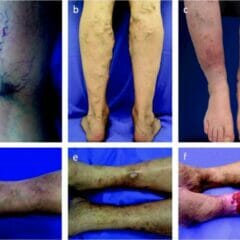Playlist
Show Playlist
Hide Playlist
Varicose Veins: Diagnosis
-
Slides 09 VascularMedicine advanced.pdf
-
Reference List Vascular Medicine.pdf
-
Download Lecture Overview
00:00 The diagnosis of venous insufficiency and superficial varicosities is not difficult. 00:07 The varicosities are usually very evident on just looking at the patient, particularly if they’re standing because the veins will fill and be very clearly seen. 00:18 There’s often a very simple test to see whether these varicose veins fill from an internal source or an external source. 00:28 Of course, one can also image this with ultrasound and so forth, and very often before one plans any kind of major vein surgery, very careful ultrasound or even MRI study will be done to understand the full aspects of the anatomy. 00:47 Therapy, well for mild varicosities, simple surgeries, elastic support stockings or leggings that compress the veins and prevent them from distending or dilating. 00:59 In fact, this is often something I recommend to my patients who are going on long plane flights that they definitely wear elastic support stockings when taking a long plane flight. 01:10 Something I do myself. 01:12 I mentioned before, sclerotherapy or scarring therapy consist of injecting of a sclerosing or fibrosing agent into the varicose vein. 01:23 And it’s used mostly for small varicose veins and they just scar down and disappear. 01:29 If they’re large and very unsightly, they may be removed surgically. 01:34 And you still are going to have venous drainage from your leg because remember the venous system is redundant. 01:41 There are many possible channels. 01:43 So removing one vein doesn’t mean that the blood won’t get out of your leg. 01:49 Chronic venous insufficiency is much more dangerous because this is a condition that can lead to deep venous thrombosis and pulmonary embolism and venous ulcers in necrotic areas of the skin. 02:05 Compression therapy helps with the putting on of compressive dressings, elastic bandages that really compress the leg more powerfully than using elastic stockings. 02:20 Often we will use medications such as aspirin to prevent a blood clot from forming. 02:26 Aspirin is a mild blood thinner. 02:27 Or pentoxifylline which actually improves the way red blood cells pass through the capillaries. 02:34 And, of course, surgical therapy may be needed, skin grafting to cover ulcers. 02:40 And recently a number of growth factors, biochemical growth factors, can be placed on ulcers or even given by injection. 02:50 And there are now specialists who deal with venous disease and all of its complications.
About the Lecture
The lecture Varicose Veins: Diagnosis by Joseph Alpert, MD is from the course Venous Diseases.
Included Quiz Questions
Varicose veins are often treated with ____? . Select the CORRECT therapy.
- Surgery.
- Infusions of iron salts.
- Acupuncture.
- Intravenous vitamin C.
Imaging of varicose veins is most commonly done by which of the following techniques?
- Ultrasound.
- CT scan without contrast.
- CT scan with contrast.
- Radiography.
- Angiography.
Sclerotherapy aids by which of the following methods?
- Producing scar tissue.
- Increasing veins elasticity.
- Increasing venous compliance.
- Reducing blood flow.
- Thinning of blood.
Customer reviews
5,0 of 5 stars
| 5 Stars |
|
2 |
| 4 Stars |
|
0 |
| 3 Stars |
|
0 |
| 2 Stars |
|
0 |
| 1 Star |
|
0 |
Joseph Alpert is very organized and thorough in his lectures. He is a great teacher.
Awesome Lecturing, great analysis and explanations. it made it real easy to follow.





